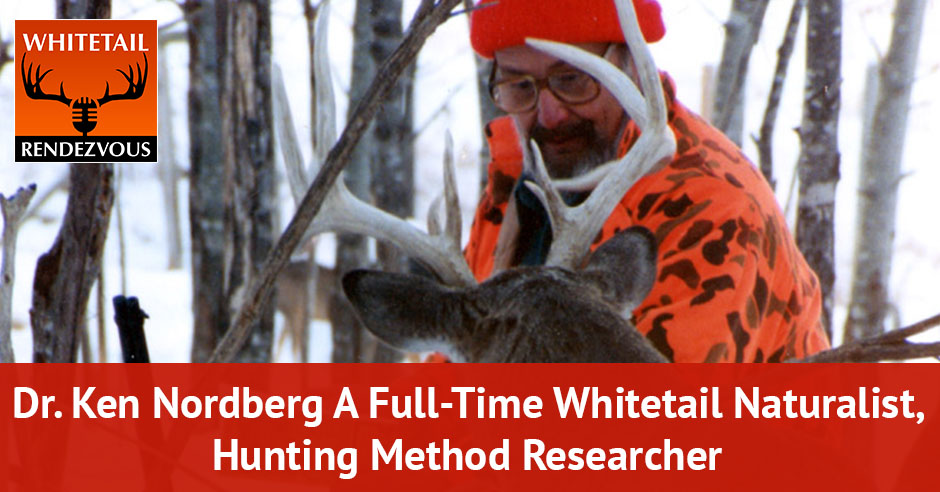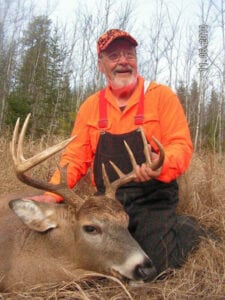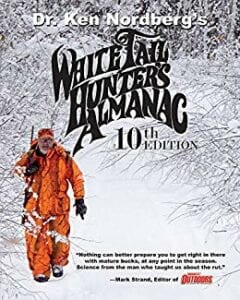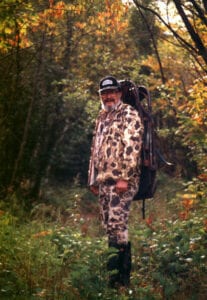
There is a lot of research that goes into the art of hunting. In this episode, Dr. Ken Norberg shares the research and methodology he has gained over decades of studying whitetail deer. Dr. Ken is a retired dentist, full-time Whitetail naturalist, hunting method researcher, wildlife photographer, seminar speaker, outdoor writer, and feature editor. He gives us his personal classification of what a mature buck is and also talks about his deer hunting camps, how they’re set up, and how much fun he has in them.
—
LISTEN TO THE PODCAST HERE:
Dr. Ken Nordberg A Full-Time Whitetail Naturalist, Hunting Method Researcher
Dr. Ken Nordberg is a full-time whitetail naturalist, hunting method researcher, outdoor writer, and wildlife photographer as well as a seminar speaker. He’s a Feature Editor of Midwest Outdoors and a Field Editor for Bear Hunting Magazine. I’m excited to have Dr. Ken Nordberg from Minnesota on the show. Dr. Ken, please say hi to our readers.
Hi, everybody. I’m happy to be here.
Give us some background on what you’ve been doing in the world of whitetails for many years.
I’m a retired dentist with three college degrees. Two of those degrees helped prepare me for studying the habits and behavior of whitetails and black bears. I began my unique hunting-related studies of wild whitetails several years ago. Since then, I’ve studied whitetails over much of North America including several years in parts of Texas, New Mexico and Arizona. My studies are ongoing. A lot of these studies have been first to introduce and describe the five stages of the whitetail rut. After using primitive treestands in my earliest years of research, I’ve been encouraging whitetails to use them ever since. Beginning back in 1980 by magazine articles, books, countless seminars and twelve-hour video series, I created in 1986 entitled Whitetail Hunter’s World, which is no longer available.
Since then, I’ve written more than 700 articles about whitetails and whitetail hunting for many popular outdoor magazines, introducing several new and much-improved hunting methods. I’ve been a Feature Writer for Midwest Outdoors for the last many years. Much of what you learn from articles written by others about whitetail hunters came from published results of my studies, which I’m rather proud of. I have also taught hundreds of hunters from all over America at my buck and bear hunting schools in the wilds of Northern Minnesota. I’ve been hunting whitetails for many years. I took three deer in my first year at age ten, being a farm kid. I’ve been hunting mature bucks only with gun and bow for many years. Rare is a year during which I have not taken a mature buck since then. At 80 years old, I still have no plans to quit hunting or studying whitetails. That’s about it.
Thank you for that background information. Dr. Ken, tell us your best hunting story. You’ve been at it for a long time. What’s the number one hunting story that strikes you as having the biggest impact on your pursuit of whitetails?
You can actually hunt bucks near where they are every day rather than where you merely hope they are. Share on XMy best story of that is short and to the point. You might entitle it to key on mature bucks only by hunting with an easy shooting range downwind, fresh track and/or droppings made by mature unalarmed, not throbbing or bounding bucks. By doing this, you can hunt bucks near where they are every day, rather than where you merely hope they are.
Let’s unpack that because you gave a lot of information. I heard downwind, I heard fresh sign. I heard that you could hunt a buck daily. I’m putting some information in here that is not disturbed if you’re hunting a similar area or similar buck on a daily basis.
In 1970, when I began my studies, I came to the obvious conclusion that little deer have little hooves, bigger deer have bigger hooves, and the biggest deer have the biggest hooves. I began measuring hooves and hoof prints of countless whitetails of both sexes, all ages and weights, live ones and dead ones. It didn’t take long to realize that I could identify five classes of deer by the lengths of their hoof prints alone. This Includes fawns, yearling does, yearling bucks and does two years of age or older. Both of them are the same size hooves. What makes a difference is that it does have babies and if you see smaller hoof prints, it’s a doe. Also, bucks two-and-a-half years of age and bucks three-and-a-half to six-and-a-half years of age, those are the bucks I like to hunt. It’s different for different states but this can be figured out for hunters in every state.
Here in Minnesota, any fresh track more than 3.25 inches long, it’s not only the track of a mature buck but it’s near. We’re near where that buck is. Either that or soon will be near at least within the next 24 hours. By track measurements of fresh deer tracks, I can key on mature bucks that are the big ones. Ignore all the rest of those tracks but hunt where those big ones are found. By our method of scouting inspired by our timber wolves which we have a lot of up in northern Minnesota, I can keep close to them throughout the hunting season. That’s the biggest reason us northerners have been particularly successful at taking mature bucks in the last many years. Where we hunt, because of a couple of severe winters and wolves, our deer numbers have plummeted by 67%, whereas hunters in surrounding areas have only been able to take one deer per ten square miles. We keep taking our usual four mature bucks. We set a limit of four each year so that we don’t want to over hunt our mature bucks in the four square miles we hunt in. We managed to take that number every year. We’re doing something right, that’s for sure.
Talk to me about your definition of a mature buck.
My definition is any buck that is older than a yearling. The yearlings have antlers. I don’t count them as mature because they’re still under the leadership and teaching of their mothers. They live in their mother’s ranges. They’re not yet able to live in the wilds on their own so I count does as immature deer. Any buck or any deer that’s two-and-a-half years of age in the fall is a mature deer. They’re able to live in the wilds on their own. That’s the definition of what I call mature. We do take two-and-a-half-year-old bucks every now and then, especially newcomers in camp. Those are their targets because they’re easier to hunt. Generally, my boys and I hunt only bucks that are three-and-a-half to six-and-a-half years of age. Those are the big guys.

How long have you been going to the same hunting camp?
The area where we hunt is not only our hunting area but it’s my primary study area, three miles from the Canadian border. We’ve been going there for many years. Those North Country mature bucks are the toughest bucks in the world to hunt. You have to do a lot of things differently than you would do in other places and in the country. We love it there, we love the country. We love the challenge of hunting bucks like that and we’re good at it. That keeps us going back to the same here.
Tell us about the actual hunting camp. What type of building? Do you have outbuildings?
We have two big wall tents and we’re about to exchange one for a bigger wall tent. We heat those tents with barrel wood stoves. We have cots and all sorts of things. We have a dining room where we all get together at noon and in the evening. I love those tents. I love camping. Camping where we hunt is half the fun. We get some cold weather but with those woodstoves of ours, we can keep warm in there when it’s as cold as 27 below zero. We had a lot of twelve below zero weather. We can be barefoot and in T-shirts in those tents when we’re at camp. I love that kind of hunting where we can be right there. The camps are established to other hunters at where we are.
Other Minnesota hunters are good about respecting the hunting areas of others. We’ve had this area where we hunt pretty much to ourselves for many years and we’re careful with that. We don’t overhunt. We’re not interested in killing out, we don’t like that. Four big bucks a year is enough for us. We have most of it made into sausages, which we enjoy. Every year out of the four bucks we’ve taken, most years one of them will be a big one, it will weigh over 300 pounds. We’ve got bucks that size in Minnesota. They will weigh about 305 pounds. The biggest one is a thirteen-pointer, whereas this area is not noted for record book racks. They have nice racks. There are nice bucks and I was proud to take them. We can’t all get bucks like that every year. If we did that, we wouldn’t have any big dominant bucks in our hunting area.
You’d impact the gene pool. How big is the acreage?
We have four square miles, not the entire amount of four square miles. One of those square miles is a denning area of timber wolves. We share our country with timberwolves and it’s about four square miles. Some of our stand sites, our more or less centrally located camp are up to two miles away. We go to those stand sites in the dark and early in the morning. We want to be at our stand sites at least a half-an-hour before first light in the morning. We don’t want to miss a minute of the first three hours of the day when we take 85% of our older bucks. We’ve had hunters there say, “You guys are dedicated here. You get up at 4:00 in the morning?” Get ready to go on and off we go about 5:30, while it’s still pitch dark out. We sit still for the next four to five hours and then we come to camp at noon and then out we go again.
Any buck or deer that's two and a half years of age in the fall is a mature deer. They’re able to live in the wild on their own. Share on XIf there’s a foot of snow, do you use snowshoes? Do you use snowmobiles? How do you get two miles away in a foot of snow?
Walk, I insist on it. I’ve got one son who’s been trying to introduce an ATV up here for years. I finally convinced him that’s wrong. If you make ATV tracks in the snow, everybody with an ATV is going to want to follow those tracks and pretty soon we’ll be looking for a new hunting area, so we walk. The trails that we use are deer trails. One year we had three feet of snow, which was in 1992, on the ground in the open area. We came down on Halloween night and we walked and it was one of our best years of buck hunting. We’ve got some great bucks that year. It’s work but it’s worth it. That’s the way we do it, we’re tough old guys.
This is a camp that’s been established for many years on public land, four square miles, sharing with wolves and they consistently take deer. I’m looking to have Dr. Ken on some other additional shows because he proves that no matter what you’re up against, whether other predators, you’re still able to take mature bucks. Why do you love whitetail hunting so much?
There are a lot of reasons. Partly, I have touched on them already. Half the fun is our deer camps. We eat good food, we get a good rest. We share all the work, we tell stories as all hunters do. To me, deer camp is the closest thing to heaven on Earth. There are other reasons. Having become good at hunting whitetails is fun for us. Imagine that you’re out there scouting two to three weeks before the open-air like we do and you find a spot that for several reasons you think, “This is a good one. I’m going to take a good buck here, look at those tracks and droppings,” all those kinds of things. On opening morning, you get the buck like you thought you would. You can’t smile wide enough when that happens.
We do that all the time. We consider hunting in two phases. The first two or three days are one phase. That’s before all the bucks we’re hunting realize they’re being hunted. From then on, when we get to phase two, we change things. We have to move to different stand sites every half day because once they know they’re being hunted, they’re going to be changing their habits, behavior and range utilization daily. We’re able to keep up to them and stay close to them. They can’t shake us and there aren’t many bucks that can continuously avoid the hunter who hunts this way and so we do well. You look forward to that. It might seem like a lot of work. All that is walking, but you look forward to it because it works and then it doesn’t work anymore. It’s fun and we look forward to it. We can’t wait to begin again. Those are the reasons I like whitetail hunting.
You mentioned stands. Are you in ground blinds? Are you in treestands? Tell us how you’ve got your camp set up.

We hunted from trees when the kids first started, back in the early 1970s. We hunted from treestands and back then, they were primitive because treestands were unheard of then, nobody hunted from treestands. Stand hunting was sitting on a stump somewhere back then. It worked well for my studies. Deer were vulnerable to that back then. You could almost reach out and touch deer walking by. Our platforms were only six feet above the ground and deer would eat right under ours and they go and lay down a few yards away. All my kids took good bucks. One of my daughters took one of the four biggest. They were taken by a Nordberg when she was thirteen from one of our early treestands.
By 1988 and 1989, we were starting to see things were changing. All of a sudden, bucks were running away from our treestands as they had never done before. They were avoiding them even if no one was in them. We could see things were not working out well. We didn’t see near as many deer. I started in 1990 trying to figure out ways to restore buck hunting like we were used to. The same was true of does and estrus. I started experimenting with ground-level hunting. After years of telling people, “If you want big bucks, you’ve got to be in a treestand,” and people say, “You’d never get me up there in a treestand.” Now, it’s the other way around. Nobody wants to leave their treestand. We hunt at ground level using backpacks, tools, and unaltered natural cover only and starting the day three or four of a hunting season.
Some of the hunters in my camp still use treestands during those first two or three days of a hunting season. It’s a great advantage. After that, because we’ve got to keep moving to stay with those bucks, we use backpack stools. Those can be carried without sound and they can be put down without a sound and you’re a lot less likely to tip off a nearby buck that you’re near them. We use natural cover. If you’re not used to hunting on the ground, you think, “That’s terrible. How do you find that?” There are all kinds of natural cover, a lot more to hide your silhouette at ground level than up in a tree.
Our bucks up there are so good at, almost everywhere nowadays, any but two-and-a-half years of age or older will quickly recognize a hunter in any stand on the ground or in a tree and begin avoiding the area. During the hunting season, most time we don’t realize that’s going on because they don’t see it happening. Once we started the ground level hunting, then things changed again and that’s our primary way of hunting deer after day three or four of a hunting season. We start with treestands early and then from then on were on the ground.
How long is your hunting season?
Two weeks.
In the wintertime is when whitetails find it hard to find food. That's when whitetails die from starvation. Share on XWhen you go into camp, do you get in there three days before, five days before, two days before?
We get in there three or four days before. We set up camp, cut wood, splinter and stack it for our stoves. We don’t do any scouting then. I remember a couple of years ago, some new people bought the land that I’ve been leasing for quite a few years. One day, they stopped at camp and they said they bought that land over there. It cost them $100,000 for 80 acres. They said, “We were disappointed. When we scouted it the day before the opening, it seemed like there was plenty of deer in there. The next day there was no deer on there.” We get up there early. I enjoy that. Us guys that are in camp early, we get good night’s sleep and we’re all set to go. In the morning, we aren’t tired from driving 265 miles from home to get there. We’re ready to go.
You mentioned leased land and public land. To clarify, are you on public land or some of the land you’re hunting leased?
We’re on federal land where it’s illegal to make trails and blinds. I’ve done a lot of work studying what kind of blinds work best. A few years ago, 50% of it was a lodge. All we had was dirt and it was disappointing. After that, we lost many deer the last few years, half of that area that was dirt then has no deer in it at all right now. We’re anxiously hoping to see some improvement. This winter was mild, we have a lot of fawns. If wolves don’t keep eating three out of four of them, by November we’ll start to see some increases again.
It’s all public land and we picked that. I picked that area because it’s especially rugged and roadless, and it’s a mean area to hunt. Even if you wanted to use ATVs there it would be hard to do because of all the boulders and everything. It’s all Canadian field of land which means there isn’t much dirt on the rocks and there are lots of rocks and boulders everywhere and that’s heavily forested. There are beautiful areas in there and we feel fortunate. Minnesota hunters are pretty good about respecting hunting areas of others and our camp’s health in that regard. That’s one of the reasons we do camp there.
Where do the deer feed? They’re moving from the bedding areas to wherever they feed. Are there acorn crops or grasses?

It’s all wild food. We don’t put in food plots, which we could. That’s not considered bait by our DNR but I think it’s bait. Food plots feed deer in spring, summer, and fall when they don’t need extra food. They don’t starve then. They eat natural foods. Clearcuts are wonderful feeding areas. I use them at the beginning of the first year. That will be the best source of thin-bladed grasses our deer love and there’s some clover out there, red clover growing in there, somehow gets in there. After the first week in November, they suddenly switch to browse up there and then their major food becomes red bark dogwood or red osiers and some other plants like moose willow and young sugar maple trees. Deer love them.
When they cut in there, the stumps will be bristling with those red suckers coming out of them. The deer love those, it’s natural food. In the wintertime when whitetails find it hard to find food, that’s when whitetails die from starvation. Especially, when the snow is deep they can’t get around much. Those red stems out there is their major food. They also eat white cedars along lakeshores up in our part of the country. They’re stuck with natural food. There have been some winters since 1990 where we’ve gone up there and put food out in wintering areas for whitetails to help them through the winter. That’s a long story too.
Do you have yarding areas for carrying them over in the cedars? Explain any yarding areas that you have in your area.
We have so-called yarding areas. I prefer to call them wintering areas and some are small, maybe only a couple of dozen deer are there during the winter. We’ve got some that are huge and there might be as many as 500 deer in there during the winter months, especially along the north shore of Lake Superior. There have been years when I’m seeing my brother. We go up there and cut trees, cedar trees and other types of food that whitetails like to get them through the winter. Wolves are often hard on them in tough winters too. They get into those yards and we’ve found places where as many as seven deer killed by wolves in one night. I suppose that was all right because it helped the surviving deer look for more food for themselves. Usually, there are lowland areas with a lot of evergreens to give them protection from bigger winter winds and deep snow. Against areas that are feeding areas full of red osiers and some sugar maples and trees like that. They’re used year after year unless they get logged and one of our major wintering areas where we hunt was logged. It will be many years before it will be a wintering area again.
Thank you for taking us to your deer camp in northern Minnesota. Dr. Ken, can you share with our readers how they can reach you if they want to go to your website, see where your books are published? Tell us about how to contact you and where your information is available.
My almanac, Whitetail Hunter’s Almanac, is on iTunes with Apple. Most of my books are available right now on the internet on Amazon. You can go to my website and order them and I’ll autograph them for you. My website address is www.DrNordbergOnDeerHunting.com. Go to that and you’ll find everything you want to know about me, a hundred older magazine articles that you can read for free. I’m on Twitter, you’ll find me there as well. It’s @DrNordberg. You have to go low on the list for me because a lot of my tweets on there are way down the list. You’ll find all kinds of good information on that as well.
Dr. Ken, thank you for being part of the Whitetail Rendezvous community. The wealth of knowledge that you shared has certainly given me a couple of ideas. I hope our readers agree. If you do, take a few minutes and tell us why you liked it. If you think it’s awesome, rate this as a five. The best way you can thank Dr. Ken for being on the show is to tell a friend. Social media allows you to impact a lot of people.
